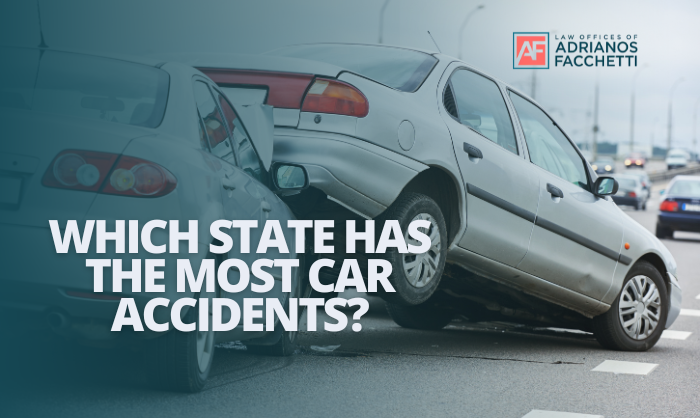Ever found yourself wondering if the place you’re driving every day is one of the riskiest spots for accidents in cars? You're not alone. Whether you’re behind the wheel for a quick errand or facing a long highway trip, knowing the risks in your state or the one you’re passing through can make a real difference.

In this post, we’re diving into the latest numbers for 2025 to answer a question many drivers ask: what state has the most car accidents? We’ve pulled fresh data from trusted sources like the NHTSA, IIHS, CDC, and local state reports to bring you clear answers.
You’ll get a state-by-state breakdown of auto accident statistics, discover the most dangerous cities, learn what times of day are riskier, and pick up some practical safety tips along the way. Plus, we’ll look at trends and factors driving these numbers, so you’re not just reading stats, you’re understanding them, and if you need local help in Burbank, start here Burbank Car Accident Lawyer . Let’s get into it.
Car Accident Statistics by State
If you’ve ever wondered how your state compares when it comes to accident figures, this is where you’ll get the full picture. We’ve laid out the latest numbers so you can quickly spot which states report higher accident rates and which ones are doing better at keeping people safe on the road.
Take South Carolina, for example it's not just about the total number of accidents but the fatal accident rate that tells the story. Rural roadways with poor conditions and longer distances between emergency services can turn a crash into a fatal car accident more often than in states with better-maintained roads.
These numbers help drivers, policymakers, and even families map out high-risk areas and think about safer travel choices. It’s also a way to push for enhancements to road maintenance and stricter traffic laws where they’re needed most.
Top 5 States with the Most Car Accidents
It's easy to assume that the biggest states have the most accidents simply because of their size, but the truth is more about patterns than just population numbers. This section breaks down the top states where accident occurrences are the highest not just in total, but also when we adjust for population size.
For example, Texas leads with numerous accidents, but when you factor in its large population, the accident death rate tells a different story. In Florida, high tourism and a larger number of elderly drivers contribute to alarmingly high accident fatalities. California’s traffic congestion pushes accident frequency up, while Georgia and North Carolina are seeing increases because of growing cities and rural roads that haven't kept up with the growth.
Knowing this helps you understand where accident risks are higher, especially if you drive across state lines or plan to relocate.
Most Dangerous Cities for Car Accidents in the U.S.
Cities often carry higher risks for accidents, not just because of more drivers but also because of factors like traffic congestion, risky behaviors, and infrastructure that’s struggling to keep pace with growth.
In places like Los Angeles, CA, heavy traffic mixed with pedestrian accidents and distracted driving raises accident figures year after year. Meanwhile, Miami deals with a mix of drunk driving incidents and poor road conditions, making it a place where safe driving practices matter even more.
By knowing which cities have the highest accident rates, you can take extra caution if you’re driving there whether you live locally or you're visiting. And if you call these cities home, it’s a reminder to push for improvements like better traffic flow and road safety campaigns.
What Time of Day Do Most Car Accidents Happen?
The time you choose to be on the road can make a bigger difference than most people think. Accidents in cars aren’t spread out evenly throughout the day. There are clear spikes, especially during late afternoons and evenings when traffic peaks and drivers are often tired or distracted.
Rural roads at night can be especially dangerous. Low visibility, impaired driving, and fewer vehicles to spot hazards early all raise the risk of accidents. Early mornings, by contrast, tend to have the lowest rates, especially on weekdays, thanks to lighter traffic and clearer road conditions.
Knowing when fatal crashes are more likely to happen can help you plan safer travel times it’s a small change that can make a real difference for you and your loved ones.
Major Risk Factors for Car Accidents
When you think about what causes car accidents, it’s usually not just one thing it’s a mix of conditions and behaviors that increase the probability of collisions. Let’s start with driver behavior. Risky actions like distracted driving, excessive speeds, or intoxicated driving are still some of the most critical factors behind deadly car crashes. Inexperienced drivers or those without proper driver education programs often struggle with safe driving protocols, which adds to the challenge for drivers on busy roads.
Then there are road conditions. Slick road surfaces, potholes, or poorly lit areas create hazardous driving conditions, especially on rural roads where wildlife interactions happen more often. Pair that with city environments packed with traffic congestion or poorly designed intersections, and the risk for drivers rises fast.
Weather also plays a pivotal role. From rain and fog to snow and icy patches, inclement weather conditions lower visibility and make braking harder, raising the likelihood of collisions.
An expert in traffic safety often reminds us: "No matter how skilled you are, the conditions for drivers around you and their behavior are just as crucial to staying safe on the road."
Are Car Accidents Increasing or Decreasing?
Looking back over the past 5–10 years, there’s been a mix of progress and concerns. Some states have seen improvements to road infrastructure and stricter enforcement of traffic laws, leading to fewer alcohol-related crashes and road deaths overall. Road safety advocates have pushed hard for safer driving practices and effective enforcement, which is making a difference in several regions.
At the same time, though, there’s been a rise in risky driver behavior, like aggressive driving and distracted driving behaviors, especially as traffic picked back up after the pandemic slowdowns. As more people returned to commuting and travel, we’ve noticed changes in driver conduct and increases in motor vehicle crash deaths in some areas.
There’s hope for the future, though. New technologies like Advanced Driver Assistance Systems (ADAS) are becoming more common, helping to reduce the probability of vehicle collisions. Ongoing investments in road infrastructure and focused initiatives on city-specific danger zones are also helping to create safer driving environments.
Understanding these trends can help you stay aware of changing risks and adopt safe driving protocols wherever you are.
Tips for Staying Safe on the Road
No matter where you drive, a few smart choices can lower your risk of accidents and help protect both you and others on the road. First, following safe driving protocols like keeping a safe distance, avoiding distractions, and respecting speed limits plays an essential role in reducing collision likelihood.
For drivers in high-risk areas or dangerous roadways, being alert for frequent wildlife crossings or sudden changes in weather is key. Rain, snow, or fog can quickly turn into hazardous driving conditions, so adjusting your speed and allowing extra braking time is a smart move.
Several states have also stepped up their road safety efforts. Road safety advocates and city officials are focusing initiatives on improving signage, investing in road infrastructure, and enforcing traffic laws to create safer conditions for drivers. Programs aimed at educating licensed drivers and encouraging responsible driver conduct are also helping to reduce fatalities among vehicle occupants.
As a driver, keeping up with these enhancements in roadway conditions and following effective strategies for safer driving can make every trip more secure whether you’re navigating busy city streets or rural roadways with less traffic but more hidden risks.
FAQs About Car Accidents by State
When it comes to car accidents, people have lots of specific questions and it makes sense because knowing the details can actually help you avoid risks. Here’s what drivers often want to know:
Which state has the highest DUI-related crashes?
Right now, states with more rural roads and fewer transportation options often see higher rates of drunk driving fatalities. For example, South Dakota has been flagged for its higher rates, partly due to the long stretches of rural roadways and fewer rideshare services in smaller towns.
What month has the most car accidents?
Accident frequency tends to rise in late summer and around the holidays. With more people traveling, distracted driving and risky behaviors increase, especially during busy times like Labor Day or the winter holidays.
Are rural or urban roads more dangerous?
It depends on what you look at. Rural roads often have higher accident death rates because of poor lighting, less traffic enforcement, and longer emergency response times. Meanwhile, urban roads see more accidents overall, thanks to traffic congestion and more interactions on roads with pedestrians, cyclists, and aggressive driving.
Do red-light cameras reduce accidents?
Yes, in many cities, they’ve been part of effective strategies to lower certain types of accidents, especially deadly car crashes at busy intersections. For example, some efforts on cities like Los Angeles show how these cameras can play a crucial role in encouraging safer driving practices. If you’re ever in a legal situation involving a red-light camera, speaking with a Los Angeles car accident lawyer could help clarify your options.
These answers don’t just satisfy curiosity they give you insights to drive smarter and safer every day.
Conclusion
No matter where you drive, being aware of the risks around you makes a real difference. Across the country, from busy city streets to rural roadways, accident patterns reveal clear signals: risky driver behavior, poor road conditions, and adverse weather all play an essential role in raising the probability of collisions.
What we’ve shared here from accident figures by state to the most dangerous times of day is meant to help you stay alert and make safer choices. Following safe driving protocols, paying attention to city-specific danger zones, and understanding where accident death rates are higher can guide you to better decisions behind the wheel.
If you found this helpful, share it with family and friends. Take a moment to check your local driving laws, stay aware of any improvements to road infrastructure in your area, and most importantly, practice safer driving every day. Being proactive isn’t just about protecting yourself it’s about making the roads safer for everyone.














